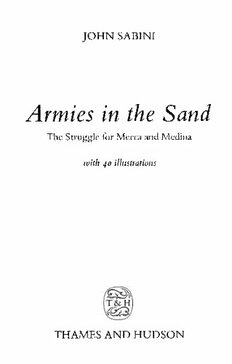
Armies In The Sand: The Struggle For Mecca And Medina PDF
Preview Armies In The Sand: The Struggle For Mecca And Medina
JOHN SABINI Armies in the Sand The Struggle for Mecca and Medina with 40 illustrations THAMES AND HUDSON For Jemima, a good travelling companion Any copy of this book issued by the publisher as a paperback is sold subject to the condition that it shall not by way of trade or otherwise be lent, re-sold, hired out or otherwise circulated, without the publisher’s prior consent, in any form of binding or cover other than that in which it is published and without a similar condition including these words being imposed on a subsequent purchaser. ©1981 Thames and Hudson Ltd, London First published in the USA in 1981 by Thames and Hudson. Inc., 500 Fifth Avenue, New York. New York 10110 All rights reserved. No part of this publication may be reproduced or transmitted in any form or by any means, electronic or mechanical, including photocopy, recording, or any information storage and retrieval system, without permission in writing from the publisher. Library of Congress Catalog Card Number 80-52095 Filmset by August Filmsetting, Reddish, Stockport. Printed and Bound in Great Britain by the Fakenham Press Ltd, Norfolk. Contents Acknowledgments 7 Note on the Transliteration of Arabic 8 Note on Currency 9 Part One : Prelude i i 1 A Terrible Land 12 2 Western Intrusions 30 3 Enlightenment 51 4 The Cleansing of the Ka‘ba 65 Part Two : Catastrophe 85 5 Men of Blood 86 6 The Passion of Shaikh Ibrahim 132 7 Viceregent of Asrail 162 Part Three: Aftermath 179 8 Jets of Flame Against the Night 180 Epilogue 207 Map of the Middle East 212 Note on Sources 213 List of Illustrations 216 Index 218 Acknowledgments First I wish to thank Miss Elizabeth Monroe, for her encouragement, guidance, and support throughout the writing of this book. Any errors of fact or interpretation that remain should be attributed not to her but to the author. My thanks are also due to Mr and Mrs John Brinton for their hospitality during the early stages of writing and for the use of their fine library on the Middle East. Mr Rodney Searight has been most generous in opening his collection of pictures on Arab and Turkish subjects for use as illustrations. Gratitude is also extended to the following for their help, advice, and encouragement: Mr William Mulligan, formerly of the Arabian American Oil Company ; Mr Ritchy Thomas, former librarian of the American University of Beirut; Miss Nawal Na‘oum, Mr and Mrs John Fistere, and Mr William Tracy. No writer on the Arabian peninsula in the eighteenth and nineteenth centuries can fail to acknowledge a great debt to the late D. G. Hogarth for his seminal work The Penetration of Arabia. Dhahran - Shemlan - London 1973-1979 7 Note on the Transliteration of Arabic The rendering of Arabic words into English letters is an unsatisfactory business. There is no English equivalent for some Arabic sounds, and Arabs make distinctions between letters that sound alike to our ears. There are also variations between spoken and written Arabic and bet ween different dialects. Each of the writers and travellers treated here used his own method, often inconsistently, and I have retained his form in direct quotation. For the rest I have used a system which I hope is at least consistent, if perhaps no more rational than another. Well-known names and words, such as Mecca and Bedouin, are given in their familiar form. The 4 or inverted apostrophe represents the letter 4ain, an essential ingredient of some Arabic words Eke 4ulama, Sa4ud, or Yanbu4; it approximates to a deep growl and often makes a friendly conversation between Arabs sound like a quarrel. Some names, such as Mehmet Ali and Omar, are given in Turkish form where appropriate, to distinguish them from their Arab equivalents. If a name or a word looks unfamiliar on the page, the reader is advised to try saying it aloud - he will probably find he has heard it before. 8 Note on Currency During the period covered by this book money from all over the world circulated freely in Arabia and other parts of the Ottoman empire. Piastres, liras, francs, louis d’or, pounds sterling, sovereigns, guineas, dollars, sequins, rupees, riyals, pagodas changed hands or were men tioned in documents, and presumably the people involved at any one time could make quick calculations of their relative values. It is almost impossible to do so today, at least in any consistent and universal way, because the value of each currency kept changing in purchasing power and in the gold and silver content of the coinage. Even if the effort were made to determine par value in terms of pounds sterling or US dollars today, with present rates of inflation the figures would be out of date within a few months. The reader is advised to think of any given amount impressionistically, either as reasonable, extortionate, or a bargain, depending on the context. The Turkish lira contained ioo piastres; in Jiddah in 1814, according to Burckhardt, fifty piastres were worth one pound sterling. The dollar so frequently mentioned was the Maria Theresa thaler, not the U S silver dollar. 9
